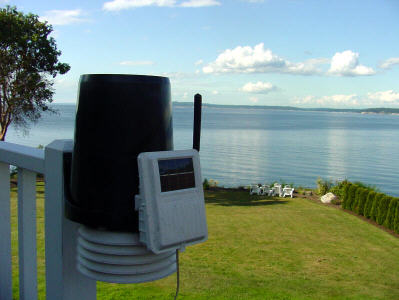
|
|
| Due to the extreme marine influence on temperatures in our area, I have installed two temperature sensors. These are labeled "Water Side" and "Protected Side". The photo above shows the Water Side sensor. It is definitely affected by the wind off the water. The "Protected Side" sensor is located in the shade on the protected side of an outbuilding. This sensor will typically show higher high temperatures in the summer and lower low temperatures in the winter because of the moderating effect of the water. The temperatures from this second sensor will be more in line with other reporting stations in the area. I have actually received error notices from Wunderground because my temperatures were not in alignment with surrounding stations. Occasionally on a day with a South wind, the temps on both sensors will match because of the offshore flow. My intention has been to report the temperature in Skunk Bay, so this will typically be different from land based stations. We have always known the wide discrepancy in temperature between the front and back yard and now we will be able to measure it. |
|
|
| The anemometer is mounted on a 30 foot mast that
is secured at the ridge of the roof on the single story side of the
house. This puts it at approximately 50 feet above ground level.
There are some trees about 150 feet to the west, and the
next closest obstructions are trees that are approximately 300 feet to
the south of the house.
The station hardware is a Davis VantagePro2 wireless. It interfaces to the computer through the Davis serial datalogger. The weather software is Virtual Weather Station by Ambient Software.
The webcam software is Sebectec. It is designed specifically for the Olympus SP500U digital camera. The cam is mounted on a remote pan/tilt so I can point it in any direction from my desk. The zoom is controlled by the software. I capture 3 images per minute. The image on the page is updated once per minute. Every hour a new time lapse is created and uploaded from the previous 6 hours. At the end of the day a time lapse for the whole day is uploaded. After dark, the cam automatically switches to an extended exposure mode. I have this set for a 20 second exposure. Since I am capturing a new image every 20 seconds on a 20 second exposure, the cam will pick up literally everything that happens at night. This allowed the capture of this image:
|